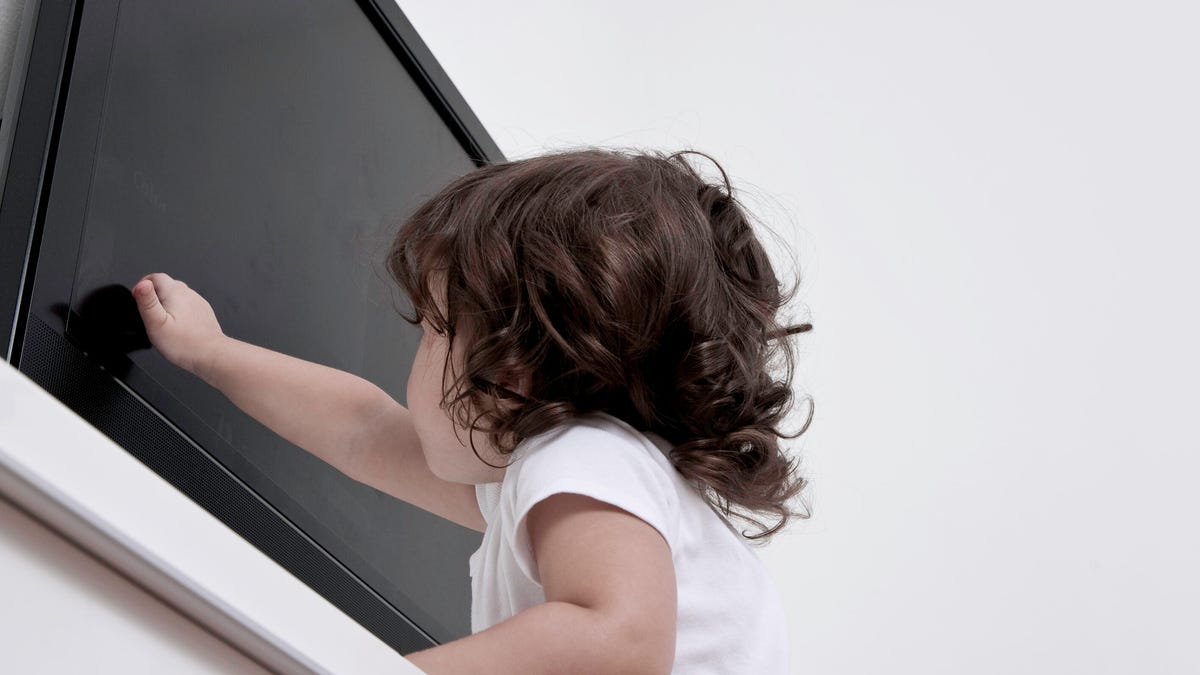 Why You Can Trust CNET
Why You Can Trust CNET It would be bad if your new TV fell over
Securing your TV to the wall only costs about $10, and it'll not only protect your television, but your kids, too.

Secure your TV to the wall to help prevent accidents with children and pets.
While TVs have gotten lighter over the years, they've also gotten larger and less stable, with many models featuring small stands that look cool, but don't protect against a serious wobble. Obviously no one wants their TV to fall over and break, especially not if you just bought it during the holiday rush. But more seriously, unstable TVs represent a safety threat, especially to children and small pets.
If a TV falls on you, you'd probably be OK. If it fell on your foot, maybe less so. If it falls on a toddler or small pet, it could cause serious injury. This happens more than you might think. According to the Consumer Product Safety Commission, 25,500 people are injured each year in TV- and furniture-related incidents, and 571 people have died between 2000 and 2019. And it's not just kids getting hurt, either. So let's figure out how to prevent your TV from falling over.
There are a few options available depending on where your TV is located and how much you want to spend. Keep in mind this is merely a guide. You should research any serious baby-proofing extensively.
Secure your TV with an inexpensive strap
From left to right: Wappa, Safety 1st, Teddykins.
The easiest, and likely cheapest, method to secure a TV is one of the many varieties of TV straps. In most cases these straps connect to the mounting holes on your flat panel, and then you drill the other end into your furniture and/or the wall. Make sure you find a stud or use drywall fasteners, since regular screws will slide out of drywall pretty easily.
Here's a serious-looking metal version available for $13 (above, left). Here's one for $9 that secures to the table and the wall (above, middle). This third option (above, right) is $20 but features long straps.
Even if you don't have kids, these are great for anyone who lives in an earthquake-prone area. A bit of a wobble could wiggle your TV over, so for a few dollars, one of these straps could probably prevent a TV topple.
A less elegant solution could be adding weight to the back of the TV's stand or feet to make it more stable and less prone to falling over. Wrist weights, for instance. If you're not concerned about the surface of your TV table, you might be able to drill the stand itself into the table. Make sure you drill a pilot hole in the stand first so it doesn't crack. But if you didn't know that, this method might not be ideal for you.
Mount your TV to the wall or furniture
You might as well put the TV far and securely out of a child's reach. Mount the TV on the wall, and you get the added bonus of freeing up some floor space. I talk about what you should consider in TV mounting in "Where should I put my TV?" and "TV weight: Fact and fiction."
Read more: Our updated list of the best TVs of 2021, plus the best universal remotes and the best streaming devices.
The short version is that you need at least one wall stud for mounting most TVs. TV mounts themselves aren't that expensive, with many models under $100.
If wall mounting isn't an option, you can get a "furniture-mounting system" or "freestanding TV mount" like this option (there are lots of others). These either mount to existing TV furniture or free-stand behind the furniture. Personally, I'd bolt a freestanding model to the wall or the furniture -- just to be safe.
Other precautions to consider when securing TVs: The remote and cables
Keep fascinating objects, like remotes and toys, away from the TV. Wrap and secure cables, so the can't be tugged on. We've concentrated on TVs, but really any furniture in your home that's taller than a toddler is potentially dangerous. Securing these to a will only take a few minutes but can make your house much safer.
It's easy to forget about televisions in a baby-proofing marathon, but they're tall and fairly heavy. While stable on their own, they're not designed to survive an onslaught of tiny, sticky and curious hands. They're definitely worth securing (ideally the hands, but what do I know?).
For more info, check out the Consumer Product Safety Commission's website Anchor It.
Note: This article was originally published in 2013 but updated in 2021 with current info, updated injury statistics, and additional links.
As well as covering TV and other display tech, Geoff Morrison does photo tours of cool museums and locations around the world, including nuclear submarines, massive aircraft carriers, medieval castles, airplane graveyards and more.
You can follow his exploits on Instagram and on his YouTube Channel. He also wrote a bestselling sci-fi novel about city-sized submarines, along with a sequel.

